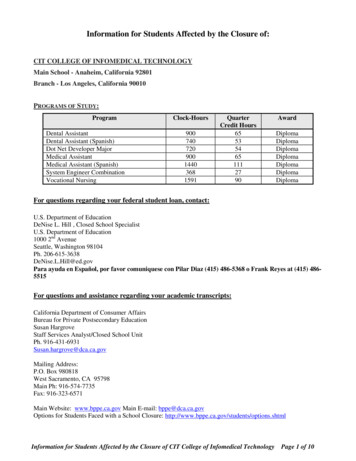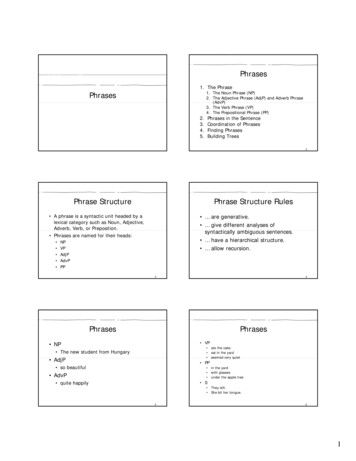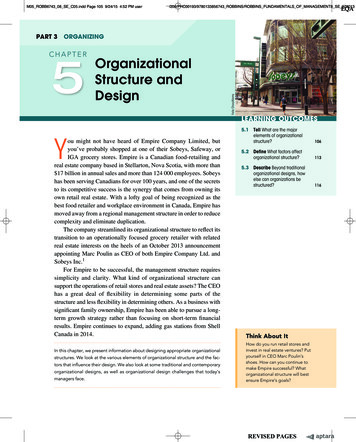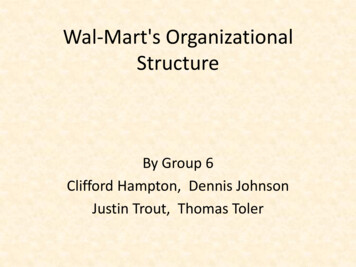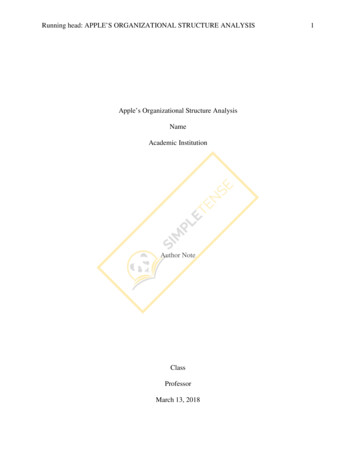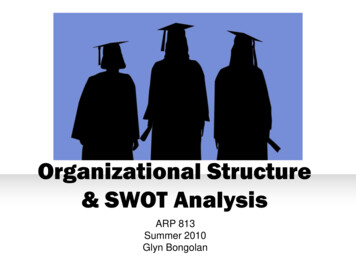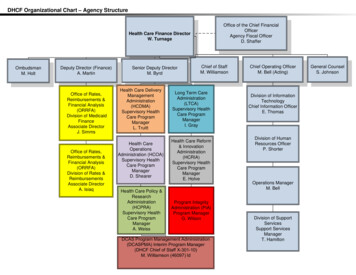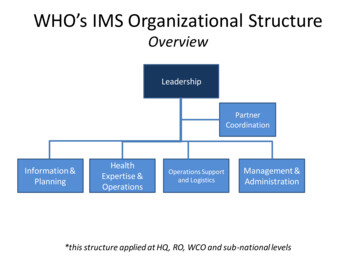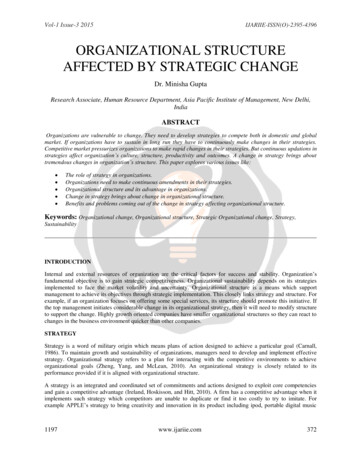
Transcription
Vol-1 Issue-3 2015IJARIIE-ISSN(O)-2395-4396ORGANIZATIONAL STRUCTUREAFFECTED BY STRATEGIC CHANGEDr. Minisha GuptaResearch Associate, Human Resource Department, Asia Pacific Institute of Management, New Delhi,IndiaABSTRACTOrganizations are vulnerable to change. They need to develop strategies to compete both in domestic and globalmarket. If organizations have to sustain in long run they have to continuously make changes in their strategies.Competitive market pressurizes organizations to make rapid changes in their strategies. But continuous updations instrategies affect organization’s culture, structure, productivity and outcomes. A change in strategy brings abouttremendous changes in organization’s structure. This paper explores various issues like: The role of strategy in organizations.Organizations need to make continuous amendments in their strategies.Organizational structure and its advantage in organizations.Change in strategy brings about change in organizational structure.Benefits and problems coming out of the change in strategy affecting organizational structure.Keywords: Organizational change, Organizational structure, Strategic Organizational change, Strategy,SustainabilityINTRODUCTIONInternal and external resources of organization are the critical factors for success and stability. Organization‟sfundamental objective is to gain strategic competitiveness. Organizational sustainability depends on its strategiesimplemented to face the market volatility and uncertainty. Organizational structure is a means which supportmanagement to achieve its objectives through strategic implementation. This closely links strategy and structure. Forexample, if an organization focuses on offering some special services, its structure should promote this initiative. Ifthe top management initiates considerable change in its organizational strategy, then it will need to modify structureto support the change. Highly growth oriented companies have smaller organizational structures so they can react tochanges in the business environment quicker than other companies.STRATEGYStrategy is a word of military origin which means plans of action designed to achieve a particular goal (Carnall,1986). To maintain growth and sustainability of organizations, managers need to develop and implement effectivestrategy. Organizational strategy refers to a plan for interacting with the competitive environments to achieveorganizational goals (Zheng, Yang, and McLean, 2010). An organizational strategy is closely related to itsperformance provided if it is aligned with organizational structure.A strategy is an integrated and coordinated set of commitments and actions designed to exploit core competenciesand gain a competitive advantage (Ireland, Hoskisson, and Hitt, 2010). A firm has a competitive advantage when itimplements such strategy which competitors are unable to duplicate or find it too costly to try to imitate. Forexample APPLE‟s strategy to bring creativity and innovation in its product including ipod, portable digital music1197www.ijariie.com372
Vol-1 Issue-3 2015IJARIIE-ISSN(O)-2395-4396device, itunes online music store, service for downloading songs and other digital music and video clips. APPLEexcels in making excellent marketing strategy to please its customers.Strategy is important for continuous growth and success of companies. It is concerned with making choicesamong available alternatives. To choose a strategy, organizations pursue one alternative over other. These choicesare influenced by opportunities or threats of organizational environment. Choice of selecting strategy is also affectedby the nature and quality of firm‟s internal resources, capabilities and core competencies. Effectively formulatedstrategies integrate, assemble and allocate firm‟s resources and competencies in order to align them in its externalenvironment. There is a variety of strategies having their own features and benefits. Some of the major classifiedstrategies are business level strategy, corporate level strategy, acquisition and restructuring strategies, internationalstrategies and cooperative strategy.I. Business level strategy: It is an integrated and coordinated set of commitments and actions that firms use to gaina competitive advantage by exploiting core competencies in specific product markets. It indicates the choice the firmto compete in challenging market situations. To make a choice is important as it is linked to a firm‟s long termperformance. Business level strategy is a core strategy that every firm must form to describe its planning to competewith others.II Corporate level strategy: It specifies actions a firm takes to gain a competitive advantage by selecting andmanaging a group of different businesses competing in various other markets. These strategies help companies toselect new strategic positions which are expected to increase firm‟s value.III Merger, Acquisition and Takeover strategies: Merger is a strategy through which firms agree to integrate theiroperations on a relatively coequal basis. Acquisition is a strategy through which can firm buys a controlling, or 100percent interest in another firm with the intent of making the acquired firm a subsidiary business within its portfolio.Here management of acquired firm reports to the management of acquiring firm. It may be a reason for resistancefrom employees. Takeover is a special type of acquisition strategy wherein the target firm does not ask the acquiringfirm‟s bid.IV International strategy: It is a strategy through which the firm sells its goods or services outside its domesticmarket. This strategy yields potential new opportunities.V Cooperative strategy: It is a strategy in which firms work together to achieve a shared objective. By cooperatingwith other companies a company is able to leverage its core competencies to grow and improve its performance. Itmay include strategic alliances and joint ventures.STRATEGIC ORGANIZATIONAL CHANGEStrategy is simply not any remedy to a problem (Johnson, 1992). It provides long term effect to organizations.Strategic decisions are gained through the application of managerial experience. They refine external and internalsources of information. If employees able to identify various requirements of the organization then, they could easilyunderstand the reasons for implementing strategic change. To gain access to restricted markets and to maintainmarket stability strategic change is implemented. Organizations want to speed up the development of goods andservices. They want to maintain market leadership in order to face uncertainty. Organizations want to share majorresources and R&D facilities in order to establish economies of scale. They want to initiate learning culture todevelop new business techniques and capabilities. To overcome the weaknesses and to gain strengths for long termsustainability, strategic change is employed.ORGANIZATIONAL STRUCTUREAn organizational structure is a set of core beliefs and assumptions encapsulated with organizational culture. Itconsiders routine behavior of organizational members, rituals of the organization, control system and reward system,with the impact of which employees respond. Organizational structure points toward a continuing pattern of tasksand activities. Organizational structures are categorized as centralized and decentralized. In comparison tocentralized organizational structure, a decentralized structure provides more flexibility in strategic change andencourages communication and participation of employees in decision making. Decentralized organizational1197www.ijariie.com373
Vol-1 Issue-3 2015IJARIIE-ISSN(O)-2395-4396structure encourages communication and increases employee satisfaction and motivation because in such structuresfree flow of lateral and vertical communication is encouraged.Organization structure is a critical component for implementing strategy effectively. A structure defines the work tobe done and how to do it, implementing organizational strategies. Effective structure provides stability to the firmswhich help in implementing strategies successfully. It helps in maintaining competitive advantage whilesimultaneously providing flexibility to develop advantages it will need in the future.IMPORTANCE OF ORGANIZATIONAL STRUCTUREOrganizational structure defines how tasks are formally divided, grouped and coordinated. The elements oforganizational structure includes: work specialization, departmentalization, chain of command, span of control,centralization and decentralization and formalization. An organizational structure specifies the directions and jobresponsibilities. It reduces employee ambiguity and confusion regarding their tasks. Organizational structure reducesambiguity for employees and clarifies their doubts and problems. It restricts employees to extent that it limits andcontrols what they do.TYPES OF ORGANIZATIONAL STRUCTURE1. Simple or Flat structure: A structure without any tight control and with high decentralized rules and regulationsis a Flat structure. Its strength lies in its simplicity and flexibility. In such structures the flow of information is veryfast and inexpensive. It is easy to maintain and it specifies job accountability clearly.2 Matrix structure: A structure that creates dual lines of authority and combines functional and productdepartmentalization. It brings specialists together and provides easy access and sharing of resources. It is highlyrigid and contains tight controls.ORGANIZATIONAL STRUCTURE AND STRATEGIC CHANGEOrganizational structure specifies the firm‟s formal reporting relationships, procedures, controls and authority anddecision making processes. It is typical to develop an organizational structure which effectively supportsorganization‟s strategic change. Every manager has to ensure that strategies are appropriate with organizationalstructure so that at the time of change both can be managed easily. Normally strategy influences structures butsometimes structure also influences planning of strategy and its successful implementation. Organization‟s strategieswork effectively only if all the elements of organizational structure are properly aligned with each other.Organization structure elements include reporting relationships and procedures. Modifications in the organization‟sexisting strategy ask for changes in its organizational structure. Organizations prefer to maintain their familiarworking structure till the time organization‟s performance starts declining and change becomes necessary.Organizational structure and strategic change have reciprocal relationships. This relationship highlights theinterconnection between strategy formulation and strategy implementation. Structure can influence current strategicactions as well as choices about future strategies. While selecting a strategy a manager should be committed tomatch strategy with organizational structure. It provides stability needed to use current competitive advantages andthe flexibility required to develop future advantages. Matching strategies with structure can create a competitiveadvantage.Organizations focus on the three main changes: innovation, cost minimization and imitation. Accordingly itsstructure should be developed or modified.Table 1: Type of business strategy and organizational structure required for it.STRATEGYInnovation strategyCost minimizationImitation1197ORGANIZATIONAL STRUCTUREFlat structureMatrix structureA combination of flat and matrix structurewww.ijariie.com374
Vol-1 Issue-3 2015IJARIIE-ISSN(O)-2395-4396To develop a strategy for brining innovation a loose structure with low specialization and low formalization isrequired. It should be decentralized. To minimize cost, organizations can develop strategy that helps in tighteningcost controls, avoiding unnecessary marketing expenses. It can be implemented in matrix structures where highlycentralized control system is followed. When organizations plan to move into new directions by ways of introducingnew products and services, then they implement initiation strategy. This strategy works well sin a mixture of flat andmatrix structure. His strategy asks for tight controls for operational activities and an easy way to undertake newactivities.IMPLEMENTING STRATEGIC CHANGETo implement strategic change is not an easy task for both big business houses and small organizations (Robbins,2003[5]). On the basis of the attitude of employees and type of structure a table is prepared which helps in findingout the outcomes of implementing strategic change.Table 2: Outcomes of combination of structures and employee attitude towards strategic change.NEGATIVEPOSITIVEMATRIXHigh resistance to changeAcceptance of change with a fear of challengeor motive of learningFLATAnxiety , frustration and littleresistance to changeHighlyacceptedbecauseofequal/greater participationConsidering flat and matrix as two main types of structures, strategic change can be implemented on the basis ofattitude of employees flowing from negative to positive and vice versa. It has four main outcomes of implementingstrategic change.1. MATRIX AND NEGATIVE: In case of hierarchical structure where people are forced to work in strict control,the implementation of strategic change is highly difficult due to high resistance of employees.2. MATRIX AND POSITIVE: Strategic change can be accepted only if people are self motivated ad willing tolearn from such changes. Change may also be accepted in case of threat to face unforeseen challenges.3. FLAT AND NEGATIVE: Due to lose control strategic change although is implemented but typically accepted asemployees may frustrate and resist changing.4. FLAT AND POSITIVIE: Strategic change can be implemented and accepted very easily as high levels oflearning is involved in it.Any significant Organizational change demands that existing ways of thinking about and talking about what we docan be overturned.LINKING STRATEGIC CHANGE T
Organizational structures are categorized as centralized and decentralized. In comparison to centralized organizational structure, a decentralized structure provides more flexibility in strategic change and encourages communication and participation of employees in decision making. Decentralized organizational . Vol-1 Issue-3 2015 IJARIIE -ISSN(O) 2395 4396 1197 www.ijariie.com 374 structure .
